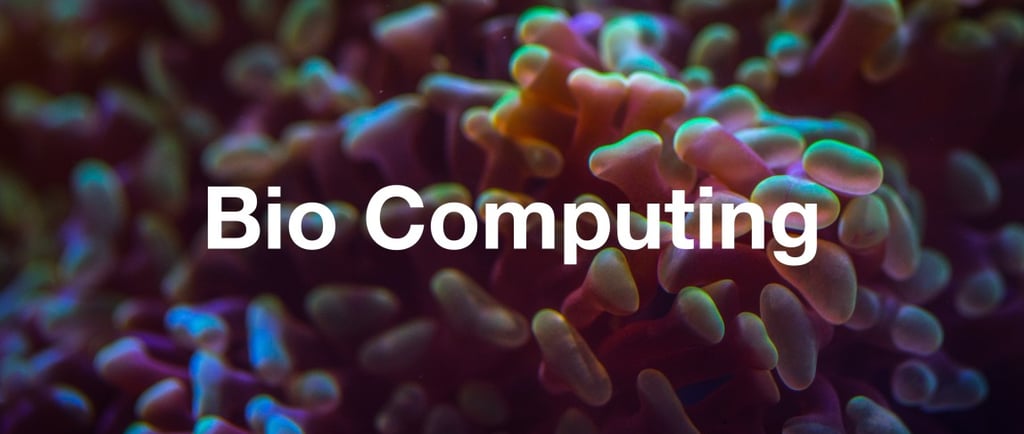items chosen one by one so you have the best option and save money on amazon (Links in articles)
The Hidden World of Biocomputing: How DNA Could Power the Next Generation of Tech
Imagine a computer that runs not on silicon and electricity, but on DNA strands and enzymes. This isn’t science fiction. It’s called biocomputing, and it could radically change how we store information, solve complex problems, and even interact with the human body. Let’s take a deep dive into this hidden world—where biology meets computing—and discover how your future tech could be grown instead of manufactured.
5/23/20253 min leer


What Is Biocomputing?
Biocomputing (or biological computing) uses biological molecules, especially DNA, to perform computational operations.
Instead of bits and transistors, it uses:
Nucleotides (A, T, C, G) as data
Enzymes and proteins as logic operators
Cells or molecular systems as the “hardware”
While traditional computers rely on electrical signals, biocomputers operate through chemical reactions, reading and writing biological data with incredible density.
Why DNA?
DNA is nature’s original storage device. Just one gram of DNA can store 215 petabytes of data.
Here’s why DNA is so promising for computing:
Durability – Can last thousands of years if stored properly
Density – Millions of times more data per cubic millimeter than hard drives
Universality – Works seamlessly with living organisms
Energy efficiency – No electricity needed for core operations
And since it’s biodegradable and renewable, DNA computing is inherently eco-friendly.
How Does a DNA Computer Work?
DNA computing was first demonstrated in 1994 by Leonard Adleman, who used DNA to solve a mathematical puzzle. Since then, things have escalated quickly.
Here’s a simplified process:
Problem Encoding: Convert a computational problem into DNA sequences.
Hybridization: DNA strands combine in test tubes to form all possible combinations (solutions).
Selection: Use biological processes to isolate the correct or best solution.
Result Reading: Read the resulting strands using sequencing technologies.
This process is massively parallel—millions of operations can happen simultaneously, something even quantum computers can’t easily do.
What Can Biocomputers Do?
Biocomputing isn't meant to replace your laptop. Instead, it's designed to solve specific types of problems that are too complex, too massive, or too biologically integrated for traditional computing.
Here are key applications:
🧬 Personalized Medicine
DNA computers could work inside your body to detect diseases, release drugs, or monitor cell activity in real time.
🧠 Neural Interfaces
By combining DNA computing with synthetic biology, we could build biological circuits that interface with neurons.
🧪 Environmental Sensors
Biocomputers can be used to detect toxins or pathogens in water, air, or soil—using cells that respond visibly when contaminants are present.
💾 Ultra-Dense Data Storage
Storing entire libraries or video archives in a single drop of DNA solution could redefine long-term archival systems.
🔍 Cryptography and AI
Some biological systems can be programmed to test combinations of keys or patterns, making them useful for brute-force decryption or genetic AI algorithms.
Who’s Working on Biocomputing?
A surprising number of institutions and companies are investing in this niche:
Microsoft – Working on DNA data storage with the University of Washington.
Harvard and MIT – Leading research in synthetic biology and DNA logic gates.
Twist Bioscience – Providing scalable DNA synthesis services for computing.
Intel & IBM – Exploring post-silicon computing alternatives.
DARPA – Funding biological logic systems for national security applications.
This is not just academic—billions of dollars are flowing into bio-digital convergence.
Biocomputing vs. Quantum Computing
Though often compared, these two fields are complementary, not competitive:
AspectQuantum ComputingBiocomputingSpeedUltrafast for mathMassive parallelismMediumQubits & superpositionDNA strands & moleculesEnergy UseHighExtremely lowMain Use CaseOptimization, encryptionMedicine, sensing, storage
Some futurists even predict hybrid systems that use both quantum and biological components.
Challenges of Biocomputing
Despite its promise, biocomputing faces real hurdles:
Speed – Molecular reactions are slower than electronic logic gates.
Scalability – Complex tasks require massive biological coordination.
Error Rates – Chemical processes can introduce noise or contamination.
Reading/Writing – Sequencing and synthesis still take time and resources.
But breakthroughs in CRISPR, synthetic biology, and automated DNA labs are rapidly addressing these issues.
Will We Ever Have Living Computers?
In some ways, we already do.
Bacteria have been engineered to solve mazes, yeast cells to count molecules, and even frog embryos turned into programmable “xenobots”—living machines that repair tissues or deliver drugs.
The line between software, hardware, and biology is blurring fast.
Final Thoughts: The Future of Life-Driven Tech
Biocomputing forces us to ask:
What if the future of technology isn’t mechanical or digital—but biological?
From storing humanity’s data in DNA to running medical diagnostics inside our veins, the possibilities are profound.
This isn’t just a new kind of computing—it’s a new way of thinking about life, intelligence, and technology as one unified system.
Stay curious. The future of tech might just be alive.